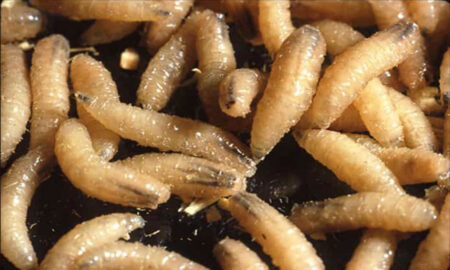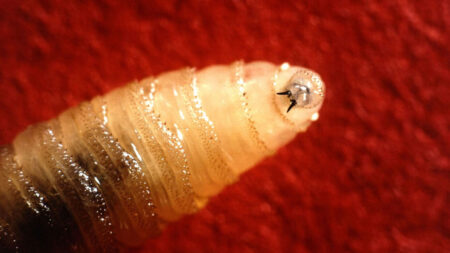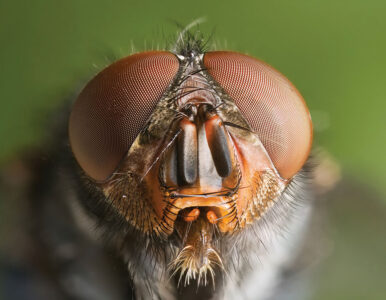Screwworms
 When I lived in the United States about 60 years ago, I became aware of a livestock pest that was prevalent in the southern part of the country, the screwworm. I worked tending show cattle, which my wife, Diane, and I took to numerous livestock expositions. Every time we passed through the city of Amarillo, Texas we had to go through screwworm control. We unloaded the cattle and dunked them in a large trench with cement walls and floor, one and a half meters wide and two meters deep. It was filled with water containing an insecticide that killed screwworms but was harmless to cattle. Men walked along the sides with poles to push the animals’ heads into the water so that each one got wet from their ears to their hooves. The purpose of the control was to stop the passage of the screwworm from southern Texas to the northern part of the United States where it did not exist. I had never seen one of these worms, but I understood that they were a serious problem and that it was necessary to keep them from spreading.
When I lived in the United States about 60 years ago, I became aware of a livestock pest that was prevalent in the southern part of the country, the screwworm. I worked tending show cattle, which my wife, Diane, and I took to numerous livestock expositions. Every time we passed through the city of Amarillo, Texas we had to go through screwworm control. We unloaded the cattle and dunked them in a large trench with cement walls and floor, one and a half meters wide and two meters deep. It was filled with water containing an insecticide that killed screwworms but was harmless to cattle. Men walked along the sides with poles to push the animals’ heads into the water so that each one got wet from their ears to their hooves. The purpose of the control was to stop the passage of the screwworm from southern Texas to the northern part of the United States where it did not exist. I had never seen one of these worms, but I understood that they were a serious problem and that it was necessary to keep them from spreading.
 When we moved to Costa Rica in the year 1970, I learned why screwworms were such a serious pest. I was familiar with the blowfly larvae we called maggots, and to me they looked just like screwworms. The difference is that maggots eat only dead organic material including animal flesh. In fact, I had read stories of military medics using them to clean wounds during wartime when limited medical equipment was available. The medics let blowflies lay eggs on the wound. The eggs hatched into maggots which ate all the dead (rotten) flesh, thus leaving the wound clean. After removing the maggots the medics did the best they could with what they had available to keep the wound clean and free of infection. Screwworms wouldn’t work in this situation because they eat living flesh.
When we moved to Costa Rica in the year 1970, I learned why screwworms were such a serious pest. I was familiar with the blowfly larvae we called maggots, and to me they looked just like screwworms. The difference is that maggots eat only dead organic material including animal flesh. In fact, I had read stories of military medics using them to clean wounds during wartime when limited medical equipment was available. The medics let blowflies lay eggs on the wound. The eggs hatched into maggots which ate all the dead (rotten) flesh, thus leaving the wound clean. After removing the maggots the medics did the best they could with what they had available to keep the wound clean and free of infection. Screwworms wouldn’t work in this situation because they eat living flesh.
 I wasn’t an environmentalist back then. I was a cattleman and managed a herd of about 150 cattle on Hacienda Barú. We had to ride through the herd on horseback a couple of times each day and check each animal for any wound, no matter how minor. Even if it didn’t already have screwworms, it soon would. The cattle didn’t get lots of cuts and gashes where the flies could lay eggs, but there was a problem with blood-eating bats, sometimes mistakenly called “vampire bats”. In large areas of rainforest or other types of natural vegetation, these bats aren’t a problem to wildlife. Their population remains stable and at a relatively low level. But when large numbers of cattle are found near a jungle where the bats live, usually in hollow trees, an unnaturally large amount of blood is available, and the bat population increases considerably. Contrary to common belief, blood-eating bats don’t suck blood from mammals. Rather they cut the animal with their razor-sharp teeth, usually on the neck or shoulders where the cattle or horses can’t use their heads or tails to whisk them away. The bats then lap up the blood, which flows freely due to an anticoagulant in the bats’ saliva. The blood then attracts the screwworm fly (Cochliomyia hominivorax), which lays its eggs in the cut. The larvae hatch and gobble up the flesh at an alarming rate thus increasing the size of the lesion. When you look at the affected area you see a seething mass of white worm-like larvae devouring the living flesh. We used a product called Larvicida, which came in a spray can, was purple in color, killed the screwworms, repelled the flies, and promoted healing. It had to be sprayed on the wound every day until healing advanced to the point that it no longer attracted screwworm flies. Whenever we found an animal with screwworms, we had to take it to the corral, put it in a chute where it couldn’t move. and apply the Larvicida.
I wasn’t an environmentalist back then. I was a cattleman and managed a herd of about 150 cattle on Hacienda Barú. We had to ride through the herd on horseback a couple of times each day and check each animal for any wound, no matter how minor. Even if it didn’t already have screwworms, it soon would. The cattle didn’t get lots of cuts and gashes where the flies could lay eggs, but there was a problem with blood-eating bats, sometimes mistakenly called “vampire bats”. In large areas of rainforest or other types of natural vegetation, these bats aren’t a problem to wildlife. Their population remains stable and at a relatively low level. But when large numbers of cattle are found near a jungle where the bats live, usually in hollow trees, an unnaturally large amount of blood is available, and the bat population increases considerably. Contrary to common belief, blood-eating bats don’t suck blood from mammals. Rather they cut the animal with their razor-sharp teeth, usually on the neck or shoulders where the cattle or horses can’t use their heads or tails to whisk them away. The bats then lap up the blood, which flows freely due to an anticoagulant in the bats’ saliva. The blood then attracts the screwworm fly (Cochliomyia hominivorax), which lays its eggs in the cut. The larvae hatch and gobble up the flesh at an alarming rate thus increasing the size of the lesion. When you look at the affected area you see a seething mass of white worm-like larvae devouring the living flesh. We used a product called Larvicida, which came in a spray can, was purple in color, killed the screwworms, repelled the flies, and promoted healing. It had to be sprayed on the wound every day until healing advanced to the point that it no longer attracted screwworm flies. Whenever we found an animal with screwworms, we had to take it to the corral, put it in a chute where it couldn’t move. and apply the Larvicida.
To readers who have little or no experience with livestock, you may think that riding a horse through the herd and checking for cuts and other lesions that might have screwworms is no big deal. But the US Department of Agriculture knows how much extra work it is to care for cattle in an area where screwworms are prevalent. Back in the days when Diane and I were stopping in Amarillo to dip our show cattle, ranchers throughout the southern US were spending a pile of money to control screwworms. A solution to the problem was urgently needed. Entomologists discovered that the female fly only mated once, laid her eggs, and died. After some experimentation, they discovered a brilliant way to deal with the screwworms. Using radiation, they sterilized millions upon millions of male screwworm flies and released them. When a sterile male mates with a wild female fly, her eggs are sterile and don’t hatch. Before long screwworms cease to be a problem for ranchers. The program was a total success and has been continued until today. The USDA estimates that the program is saving cattlemen in the US 200 million dollars each day.
It has been such a long time since I have seen a living screwworm that I had to search on the internet to find out what they look like. I found that occasional localized outbreaks are quickly brought under control. One of the most notable was in the Florida Keys where a small deer, called the “Key Deer”, lives. The insurgence of screwworms was so great that the already endangered deer were dying from it. Fortunately, the USDA was able to get the pestilence under control before irreversible harm was done.
Recently, near the end of September 2023, I saw on the local news that a case of screwworms had been discovered in Costa Rica, the first in many years. A few days later I read in The Tico Times there have been seven confirmed cases near the Costa Rica – Panama border. As I write these words sterile male screwworm flies are being released over the affected area. Hopefully, the outbreak will be terminated quickly.
Jack Ewing was born and educated in Colorado. In 1970 he and his wife Diane moved to the jungles of Costa Rica where they raised two children, Natalie and Chris. A newfound fascination with the rainforest was responsible for his transformation from cattle rancher into environmentalist and naturalist. His many years of living in the rainforest have rendered a multitude of personal experiences, many of which are recounted in his published collection of essays, Monkeys are Made of Chocolate. His latest book is, Where Jaguars & Tapirs Once Roamed: Ever-evolving Costa Rica.

